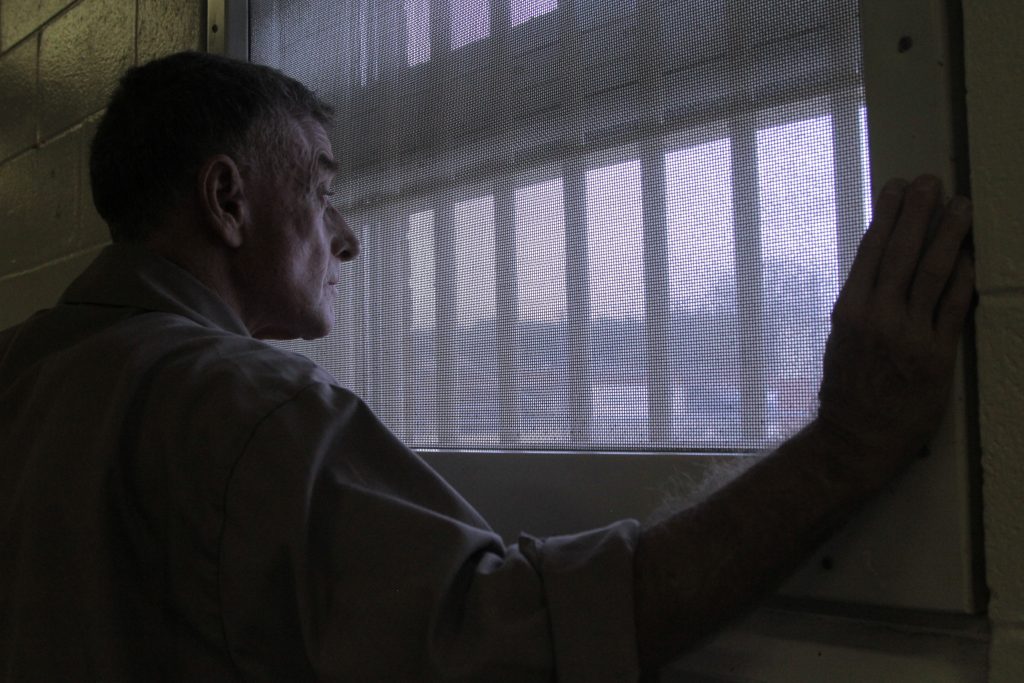Pete and I recently watched and discussed the Netflix true crime thriller, The Staircase—here’s our wrap-up.
A LITTLE HISTORY
The docuseries, created by documentary filmmaker, Jean-Xavier de Lestrade, originally aired in America as an eight part series back in 2005, then in 2013 there were two more chapters added, and later the final three chapters. Netflix is currently streaming the entire series.
The Staircase follows the trial of novelist Michael Peterson who was charged in 2003 for the murder of his wife, Kathleen Peterson.
Kathleen and Michael married in 1997 and lived in Durham, North Carolina. Kathleen already had a daughter, Caitlin, and Michael had two sons, Clayton and Todd, and two daughters, Margaret and Martha—they were not his biological daughters, their parents, George and Elizabeth Ratliff, had been good friends with Michael and his ex-wife, Patty, in Germany, and they both died (Liz’s death would be a big issue in Michael’s trial). George and Elizabeth both asked in their wills that Michael and Patty take care of their children. So when Michael and Kathleen married, their household included her daughter, and his four children.

According to all their friends and family members, the Petersons appeared to be the idea family, and Michael and Kathleen’s marriage was a happy one.
But this family was torn apart on December 9, 2001, when Michael Peterson made two calls from his home to 911 to report that his wife, Kathleen, had fallen down the steps. The first time he called, he’d claimed that she was still breathing, but the second time he said that she had stopped breathing.
According to Michael, they had dinner and watched a movie, drank some wine, and then went out to the pool and talked. When Kathleen went inside, Michael stayed out by the pool alone. When he came in, he found Kathleen at the foot of the stairs, covered in blood. There was blood on the walls and the floor, as well. Michael assumed she had fallen. But when detectives arrived, they right away made up their minds that this was not the scene of an accident, this was a murder, and since Michael was the only one home, he was soon charged.
THE TRIAL
The first eight chapters cover Michael and his legal team, led by the passionate David Rudolf, preparing for the trial, and then the trial itself, which ended in Michael’s conviction. There are many surprises and twists that came out during the trial, and I’m not going to cover all of it, but here’s some of the key points:
- Michael’s Bisexuality: Detectives found porn on Michael’s computer, as well as emails he had written to another man which detailed his plans to meet up and have sex. According to the prosecution, this was motive. They believed that Kathleen had found the material on his computer and confronted him, that they’d argued, and that Micheal had killed her. But according to Michael, Kathleen not only knew about him being bisexual, but was okay with it. Michael’s legal team fought to have this information kept out of trial, but Judge Orlando Hudson allowed it. He later admitted that he would have made a different decision now, as this was prejudicial against Michael. Indeed, I agree, I think it had a lot of influence, extremely clear when the Assistant DA, Freda Black, told the jury that the material on Michael’s computer was “Pure-T filth.” She didn’t hide her disgust at all, and I wonder if even Kathleen’s sisters and her daughter, if they had never known about his sexuality, I wonder if they would have believed he killed Kathleen. Who knows, though. Kathleen is not here to tell us. Maybe she knew, and she was okay with it. Or maybe she didn’t. In any case, Michael didn’t seem too disturbed about the whole world finding out that he was bisexual, so I can’t imagine that Kathleen’s finding it out would have been so horrible for him that he murdered her.
- Elizabeth Ratliff’s Death: Another detail that the defense team fought hard to have withheld from the trial but that ultimately was allowed—remember Michael’s daughters, Margaret and Martha? Their mother who had died when they were just babies was also found at the bottom of a staircase, and Michael Peterson was the last person who had been with her. A bizarre coincidence, yes, but the medical examiner at that time had said she died from a brain hemorrhage. The prosecution has Elizabeth exhumed and performs another autopsy, declaring that her injuries were caused by a “homicidal assault”, wording which stuns defense attorney, David Rudolf. It should be noted that Elizabeth’s daughters, Margaret and Martha, stand with Michael through his trial and beyond, never believing (or at least never admitting to believing) that he killed their birth mother, or Kathleen.
- Blood Spatter: This was a big deal and would become even bigger later. The prosecution’s expert, Duane Deaver, claimed the blood patterns were consistent with a beating, and not a fall down the stairs. While the defense’s experts, Werner Spitz and Henry Lee (you might know them from the JonBenet Ramsey case), claim that the blood spatter is more consistent with a fall.
- The Blow Poke that Wouldn’t Go Away: The prosecution suggests that a blow poke which was gifted to the Petersons by Kathleen’s sister, Candace, was the murder weapon and that it mysteriously disappeared. By the end of the trial, though, the blow poke had just as mysteriously turned back up. So essentially the DA had no murder weapon. And there would be yet another new detail to come years later about that blow poke.

DIRTY DEAVER
Chapters nine and ten bring us back to the case after the shocking discovery that Duane Deaver, who was the prosecution’s big blood spatter expert and whose testimony was likely the key thing that put Michael away, had withheld evidence in another case in which an innocent man went to prison for 17 years. As for Michael’s case, Judge Orlando Hudson found that Deaver had given misleading information and had lied about his training and expertise. The defense would later uncover other misconducts, such as in the case of that mysterious blow poke—it turns out that detectives had found it back when the case first started, had actually taken it outside and taken photographs of it, and then put it back, but never disclosed that to the defense. In short, Micheal Peterson, guilty or not, did not get a fair trial, and so he was released under house arrest to await a new trial.

NO REAL CLOSURE, BUT AT LEAST AN END
The final three chapters take us through the years following Michael’s release, the back and forth fighting with the DA (which changed several times) and with Kathleen’s family, and ultimately ending with Michael’s Alford Plea, basically pleading guilty not because he was admitting guilt, but because he was by now an old man and did not trust the legal system to give him a fair trial. Also, David Rudolf, who stood faithfully by Michael’s side throughout the whole thing, was understandably exhausted with it all. When the first trial ended with a guilty conviction, Rudolf was as devastated with the verdict as Michael and his family were. So, after a furious lashing from Kathleen’s sister, Candace, Michael was sentenced to a maximum of 86 months and released for time already served. Michael Peterson still proclaims his innocence.
The big mystery is, of course, did Michael kill Kathleen. We’ll never know exactly what happened that night. All we have to go on is what Michael says happened. But it’s like David Rudolf points out several times, the defense’s job was not to prove his innocence, only to show that there was a reasonable doubt, and there was. But the film leaves no doubt whatsoever that the justice system failed here, and that was the purpose of The Staircase documentary, not to prove innocence or guilt, but to take a close look at the American justice system.
SOME FINAL OBSERVATIONS
During our chats, Pete and I both touched on how, even though we didn’t necessarily believe Micheal was guilty, there were aspects of the man’s personality that were troubling. He often came off as … kind of egotistical. He would laugh and joke when really it seemed inappropriate, but then again, everybody is different in how they respond to stress, so maybe that was just his way of dealing with it. And then there were times when he’d say things that, under the circumstances, came off almost like a confession. One instance in particular that stood out was near the end, he said something along the lines of, “It’s like when you get away with something and you keep getting away with it, then it becomes okay.” He was referring to his keeping his sexuality a secret, but again, considering the circumstances, a very strange thing to say.
One thing is for sure, a Shakespeare line that Michael seemed particularly enamored with sums up this whole case: “All are punished.” Everyone touched by the death of Kathleen Peterson suffered in one way or another.
Check out The Staircase on Netflix, and if you’re interested, David Rudolf breaks down each chapter on his website. Also, google “the owl theory”, an interesting take that wasn’t brought up in the docuseries. It sounds absurd at first, but it’s actually a quite compelling theory.
Pete and I would love to hear your thoughts on the documentary, and the case. What do you think happened that night? What are your theories? And what about the American justice system? Did it fail in the Michael Peterson case? Please take a moment and share your thoughts with us.
Before you go:
Colony: Talk Colony Podcast Has Buzz from the Block with Nicki Micheaux
Colony: Talk Colony Podcast Discusses Episode 3.08 ‘Lazarus’

Leave a Reply